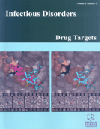-
s Role of Inhibitory BCR Co-Receptors in Immunity
- Source: Infectious Disorders - Drug Targets (Formerly Current Drug Targets - Infectious Disorders), Volume 12, Issue 3, Jun 2012, p. 181 - 190
-
- 01 Jun 2012
Abstract
B lymphocytes (B cells) express a variety of membrane molecules containing immunoreceptor tyrosine-based inhibition motifs (ITIMs) in the cytoplasmic region such as FcγRIIB, FCRLs, CD22, mouse Siglec-G/human Siglec-10, PECAM-1, mouse PIR-B/human LIRB1 and LIRB2PD-1 and CD72. When phosphorylated, ITIMs in these molecules recruit and activate phosphatases such as SH2 domain-containing protein tyrosine phosphatase 1 (SHP-1), SHP-2, SH2 domain- containing inositol 5-phosphatase 1 (SHIP1) and SHIP2 depending on receptors. These phosphatases then negatively regulate B cell antigen receptor (BCR) signaling. Because of their ability to inhibit BCR signaling, these ITIMcontaining molecules are called inhibitory BCR co-receptors. Studies on mice deficient in an inhibitory co-receptor have demonstrated that the inhibitory co-receptors regulate B cell development, antibody responses and development of autoimmune diseases. Moreover, polymorphisms in some inhibitory co-receptors such as FcγRIIB, FCRL3 and CD72 are associated with autoimmune diseases, suggesting a crucial role of inhibitory co-receptor polymorphisms in the regulation of autoimmune diseases. The ligands for inhibitory co-receptors regulate their inhibitory activity by inducing co-ligation of the co-receptors with BCR or some other regulatory mechanisms. Inhibitory co-receptors and their ligands are therefore good targets for controlling antibody responses and autoimmune diseases.


